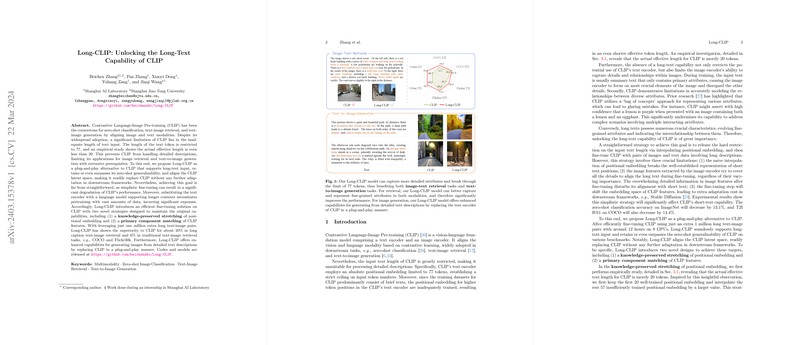An Analysis of Long-CLIP: Enhancing CLIP's Long-Text Capabilities
The paper "Long-CLIP: Unlocking the Long-Text Capability of CLIP" presents an advanced framework designed to extend the capabilities of Contrastive Language-Image Pre-training (CLIP) by accommodating longer text inputs. CLIP, a foundational multimodal model, has been instrumental in tasks such as zero-shot classification, text-image retrieval, and text-to-image generation. However, its limitation in processing longer text descriptions has constrained its usability. This paper addresses these limitations by proposing Long-CLIP, a significant modification enhancing CLIP's ability to process detailed textual data.
Key Contributions
The primary limitation of the original CLIP model is its text input restriction to 77 tokens, resulting in an effective length of less than 20 tokens. This inadequacy hampers CLIP’s ability to manage detailed descriptions essential for nuanced image retrieval and generation tasks. Long-CLIP emerges as a viable solution, providing a plug-and-play replacement for CLIP, which supports extensive text inputs and further improves its zero-shot generalizability.
The research introduces two innovative strategies:
- Knowledge-Preserved Stretching of Positional Embedding: This strategy involves retaining the first 20 well-trained positional embeddings while applying interpolation to extend beyond 77 tokens without disrupting existing representations. This method crucially maintains the original capabilities of CLIP.
- Primary Component Matching of CLIP Features: Here, the model aligns both fine-grained image features with long descriptions and coarse-grained features with short text summaries. This dual alignment ensures the model captures comprehensive details while prioritizing essential aspects.
Experimental Insights
The authors conducted extensive experiments to validate Long-CLIP's performance. Leveraging an additional million long text-image pairs, they realized a marked enhancement in retrieval tasks, with significant improvements of 20% in long-caption image retrieval and 6% in traditional tasks like COCO and Flickr30k. The model's zero-shot classification ability remained unaffected despite handling longer input texts.
Notably, the research highlighted Long-CLIP's ability to maintain the latent space alignment of the original CLIP, enabling seamless integration into existing frameworks without further modification. This capability was particularly demonstrated in text-to-image generation tasks using Stable Diffusion, where Long-CLIP outperformed its predecessor by incorporating more detailed prompts in the generation process.
Implications and Future Directions
The implications of Long-CLIP are twofold. Practically, it expands the scope of CLIP-enabled applications by effectively handling long and intricate text descriptions, thereby enhancing the utility in detailed image annotations, retrieval, and generation scenarios. Theoretically, the devised techniques of positional embedding stretching and component matching offer a template for similar enhancements in other multimodal models confronting context-length limitations.
Future developments could explore further scalability and potential applications of Long-CLIP in more complex multimodal settings. Given the burgeoning demand for sophisticated AI models capable of processing comprehensive text inputs, Long-CLIP represents a substantial step forward, demonstrating the continued evolution of CLIP-based architectures in addressing the intricate challenges posed by multimodal learning.
In conclusion, the introduction of Long-CLIP marks a substantial advancement in the landscape of multimodal models, providing a robust solution to the prevalent challenge of limited text input capabilities within CLIP. The methodological innovations and empirical accomplishments of this paper lay the groundwork for subsequent explorations into enhanced text-image alignment techniques.
